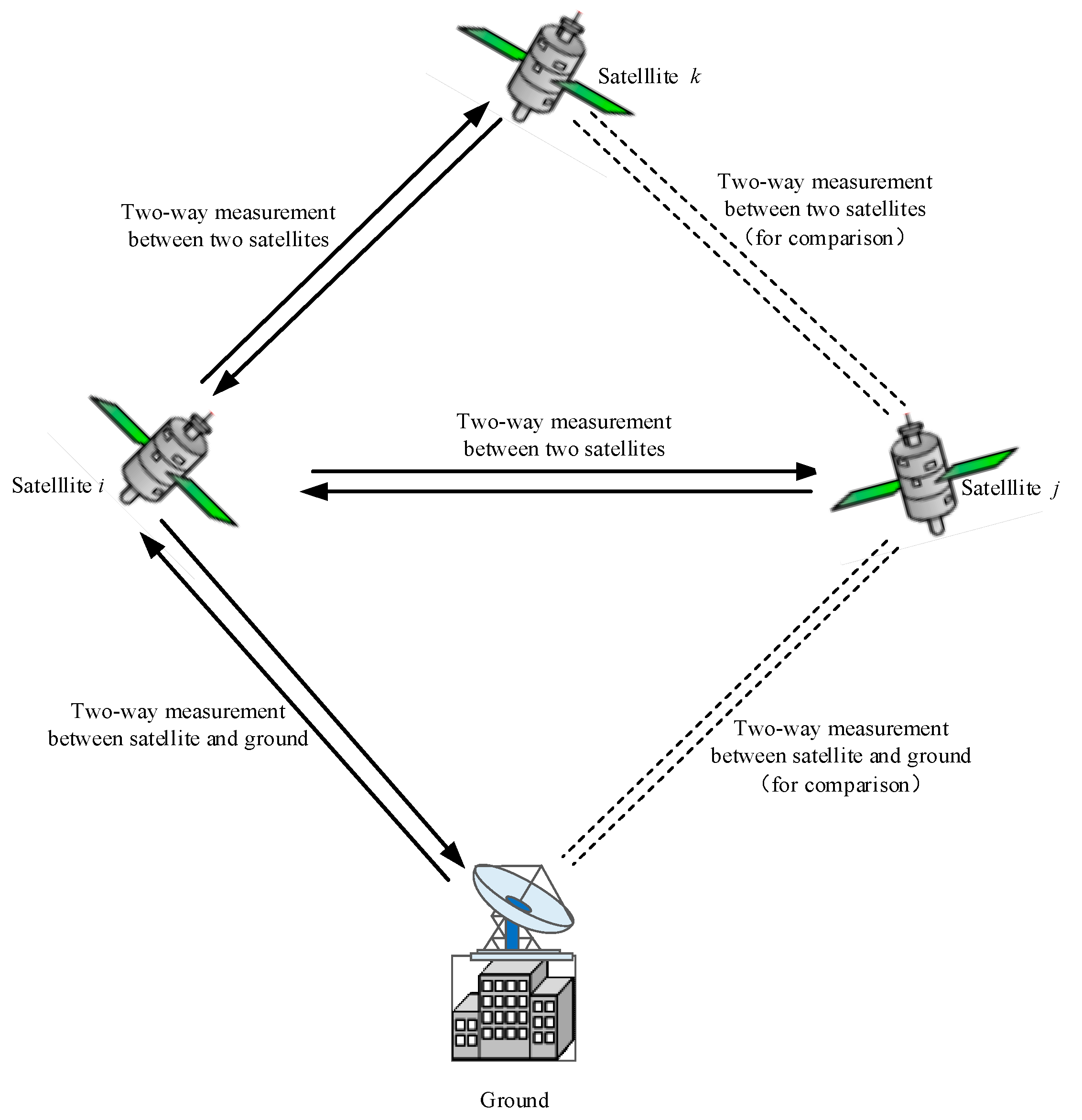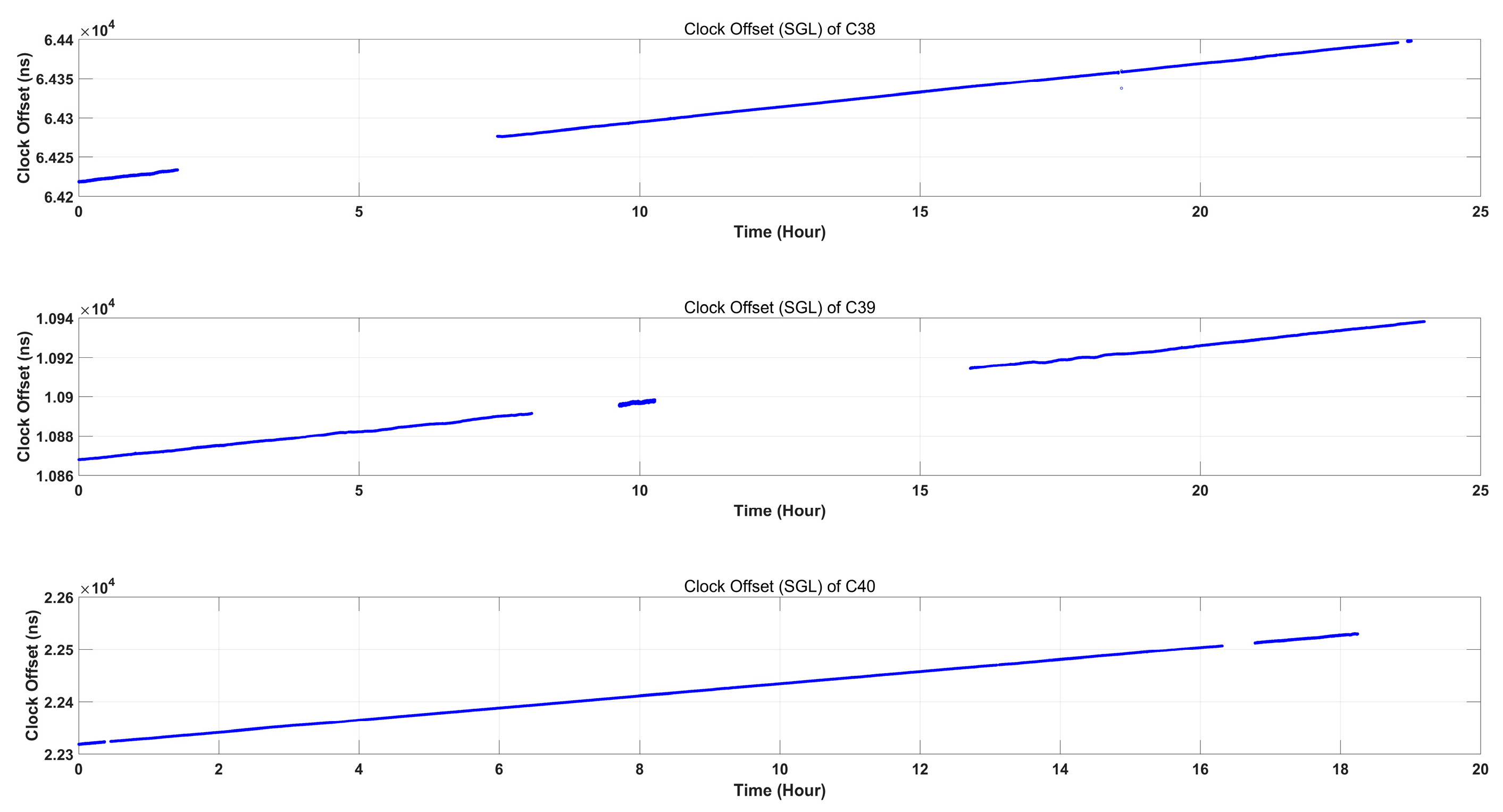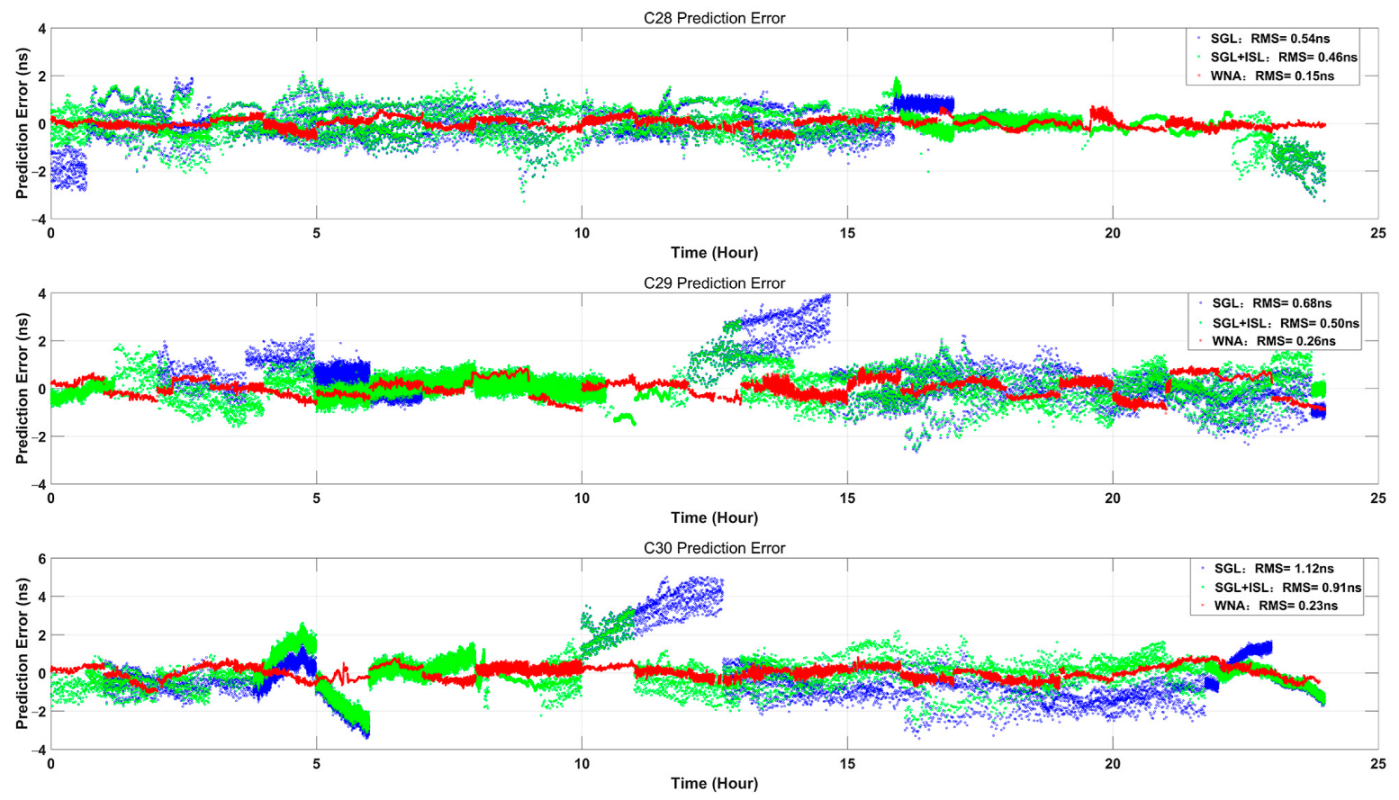A Method of Whole-Network Adjustment for Clock Offset Based on Satellite-Ground and Inter-Satellite Link Observations
Abstract
1. Introduction
2. Materials and Methods
2.1. Time Synchronization Principle
2.1.1. L-Band Satellite-Ground Two-Way Time Synchronization
2.1.2. Ka-Band Inter-Satellite Two-Way Time Synchronization
2.2. Whole-Network Adjustment Method
2.3. Accuracy Evaluation Method
2.3.1. Fitting Residual
2.3.2. Prediction Error
2.3.3. Closure Error
3. Results
3.1. Data Situation
3.2. Fitting Residual
3.3. Prediction Error
3.4. Closure Error
4. Conclusions
Author Contributions
Funding
Data Availability Statement
Acknowledgments
Conflicts of Interest
References
- Tan, S.S. Innovative development and forecast of BeiDou system. Acta Geod. Cartogr. Sin. 2017, 46, 1284–1289. [Google Scholar]
- China Satellite Navigation Office. BeiDou Navigation Satellite System Open Service Performance Standard (Version 3.0). 2021. Available online: http://www.beidou.gov.cn/xt/gfxz/202105/P020210526216231136238.pdf (accessed on 10 August 2022).
- Yang, Y.X.; Gao, W.G.; Guo, S.R.; Mao, Y.; Yang, Y.F. Introduction to BeiDou-3 navigation satellite system. Navigation 2019, 66, 7–18. [Google Scholar] [CrossRef]
- Yang, Y.X.; Mao, Y.; Sun, B.J. Basic performance and future developments of BeiDou global navigation satellite system. Satell. Navig. 2020, 1, 1–8. [Google Scholar] [CrossRef]
- Ruan, R.G.; Jia, X.L.; Feng, L.P.; Zhu, J.; Hu, Y.Z.; Li, J.; Wei, Z. Orbit Determination and Time Synchronization for BDS-3 Satellites with Raw Inter-Satellite Link Ranging Observations. Satell. Navig. 2020, 1, 8. [Google Scholar] [CrossRef]
- Wang, D.X.; Xin, J.; Xue, F.; Guo, R.; Chen, J.P. Prospect and development of GNSS autonomous navigation based on inter-satellite link. J. Astronaut. 2016, 37, 1279–1288. [Google Scholar]
- Ananda, M.P.; Bernstein, H.; Cunningham, K.E.; Feess, W.A.; Stroud, E.G. Global positioning system (GPS) autonomous navigation. In Proceedings of the Position Location and Navigation Symposium, the 1990’s-A Decade of Excellence in the Navigation Sciences, Las Vegas, NV, USA, 20 March 1990; pp. 497–508. [Google Scholar]
- Avila-Rodriguez, J.A.; Wallner, S.; Hein, G.W.; Eissfeller, B. A vision on new frequencies, signals and concepts for future GNSS systems concepts for future GNSS systems. In Proceedings of the 20th International Technical Meeting of the Satellite Division of the Institute of Navigation, Fort Worth, TX, USA, 25–28 September 2007. [Google Scholar]
- Tang, G.F.; Yang, W.F.; Su, R.R.; Xia, A.M. Time Synchronization Method base on Combined Satellite-Ground and Inter-satellite Observation. Geomat. Inf. Sci. Wuhan Univ. 2018, 43, 183–187. [Google Scholar]
- Sun, L.Y.; Wang, Y.K.; Huang, W.D.; Yang, J.; Zhou, Y.F.; Yang, D.N. Inter-satellite Communication and Ranging Link Assignment for Navigation Satellite Systems. GPS Solut. 2018, 22, 38. [Google Scholar] [CrossRef]
- Pan, J.Y.; Hu, X.G.; Zhou, S.S.; Tang, C.P.; Guo, R.; Zhu, L.F.; Tang, G.F.; Hu, G.M. Time synchronization of new-generation BDS satellites using inter-satellite link measurements. Adv. Space Res. 2018, 61, 145–153. [Google Scholar] [CrossRef]
- Yang, Y.F.; Yang, Y.X.; Hu, X.G.; Tang, C.P.; Guo, R.; Zhou, S.S.; Xu, J.Y.; Pan, J.Y.; Su, M.D. BeiDou-3 broadcast clock estimation by integration of observations of regional tracking stations and inter-satellite links. GPS Solut. 2021, 25, 57. [Google Scholar] [CrossRef]
- Chen, J.P.; Hu, X.G.; Tang, C.P.; Zhou, S.S.; Guo, R.; Pan, J.Y.; Ran, L.; Zhu, L.F. Orbit determination and time synchronization for new-generation beidou satellites: Preliminary results. Sci. Sin. Phys. Mech. Astron. 2016, 46, 119502. [Google Scholar]
- Yang, Y.X.; Xu, Y.Y.; Li, J.L.; Yang, C. Progress and performance evaluation of BeiDou global navigation satellite system: Data analysis based on BDS-3 demonstration system. Sci. China Earth Sci. 2018, 61, 614–624. [Google Scholar] [CrossRef]
- Cai, H.L.; Meng, Y.N.; Geng, T.; Xie, X. Initial Results of Precise Orbit Determination Using Satellite-Ground and Inter-Satellite Link Observations for BDS-3 Satellites. Geomat. Inf. Sci. Wuhan Univ. 2020, 45, 1493–1500. [Google Scholar]
- Yang, Y.F.; Yang, Y.X.; Hu, X.G.; Chen, J.P.; Guo, R.; Tang, C.P.; Zhou, S.S.; Zhao, L.Q.; Xu, J.Y. Inter-Satellite Link Enhanced Orbit Determination for BeiDou-3. J. Navig. 2020, 73, 115–130. [Google Scholar] [CrossRef]
- Yan, X.Y.; Huang, G.W.; Zhang, Q.; Wang, L.; Qin, Z.; Xie, S. Estimation of the Antenna Phase Center Correction Model for the BeiDou-3 MEO Satellites. Remote Sens. 2019, 11, 2850. [Google Scholar] [CrossRef]
- Wang, Q.S.; Jin, S.G.; Yuan, L.L.; Hu, Y.J. Estimation and Analysis of BDS-3 Differential Code Biases from MGEX Observations. Remote Sens. 2019, 12, 68. [Google Scholar] [CrossRef]
- Liu, C.; Gao, W.G.; Pan, J.Y.; Tang, C.P.; Hu, X.G.; Wang, W.; Chen, Y.; Lu, J.; Su, C.C. Inter-satellite clock offsets adjustment based on closed-loop residual detection of BDS inter-satellite link. Acta Geod. Cartogr. Sin. 2020, 49, 1149–1157. [Google Scholar]
- Guo, Y.; Gao, S.; Bai, Y.; Pan, Z.; Liu, Y.; Lu, X.; Zhang, S. A New Space-to-Ground Microwave-Based Two-Way Time Synchronization Method for Next-Generation Space Atomic Clocks. Remote Sens. 2022, 14, 528. [Google Scholar] [CrossRef]
- Huang, G.; Zhang, Q.; Xu, G. Real-time clock offset prediction with an improved model. GPS Solut. 2014, 18, 95–104. [Google Scholar] [CrossRef]
- Pan, J.Y.; Hu, X.G.; Tang, C.P. System error calibration for time division multiple access inter-satellite payload of new-generation Beidou satellites. Chin. Sci. Bull. 2017, 62, 2671–2679. [Google Scholar] [CrossRef][Green Version]
- Bates, J.M.; Granger, C.W. The Combination of forecasts. Oper. Res. Soc. 1969, 20, 451–468. [Google Scholar] [CrossRef]
- Liu, L.; Zhu, L.F.; Han, C.H.; Liu, X.P.; Li, C. The model of radio two-way time comparison between satellite and station and experimental analysis. Chin. Astron. Astrophys. 2009, 33, 431–439. [Google Scholar] [CrossRef]







| Satellite | SGL+ISL Method | WNA Method | Improvement Rate |
|---|---|---|---|
| C38 | 0.21 | 0.13 | 19.05% |
| C39 | 0.20 | 0.12 | 19.05% |
| C40 | 0.19 | 0.12 | 16.67% |
| C25 | 0.34 | 0.13 | 50.00% |
| C26 | 0.26 | 0.13 | 30.95% |
| C27 | 0.34 | 0.13 | 50.00% |
| C28 | 0.34 | 0.12 | 52.38% |
| C29 | 0.35 | 0.13 | 52.38% |
| C30 | 0.38 | 0.15 | 54.76% |
| C19 | 0.32 | 0.12 | 47.62% |
| C20 | 0.41 | 0.11 | 71.43% |
| C21 | 0.28 | 0.10 | 42.86% |
| C22 | 0.31 | 0.14 | 40.48% |
| C23 | 0.39 | 0.15 | 57.14% |
| C24 | 0.28 | 0.12 | 38.10% |
| C32 | 0.36 | 0.13 | 54.76% |
| C33 | 0.42 | 0.19 | 54.76% |
| C34 | 0.31 | 0.12 | 45.24% |
| C35 | 0.25 | 0.10 | 35.71% |
| C36 | 0.37 | 0.14 | 54.76% |
| C37 | 0.38 | 0.12 | 61.90% |
| C41 | 0.32 | 0.10 | 52.38% |
| C42 | 0.22 | 0.10 | 28.57% |
| C43 | 0.32 | 0.13 | 45.24% |
| C44 | 0.41 | 0.17 | 57.14% |
| C45 | 0.29 | 0.13 | 38.10% |
| C46 | 0.29 | 0.10 | 45.24% |
| Mean | 0.32 | 0.13 | 45.06% |
| Satellite | Only SGL Method | SGL+ISL Method | WNA Method | Improvement Rate 1 (WNA Relative to Only SGL) | Improvement Rate 2 (WNA Relative to SGL+ISL) |
|---|---|---|---|---|---|
| C38 | 0.60 | 0.49 | 0.29 | 51.67% | 40.82% |
| C39 | 0.40 | 0.40 | 0.28 | 30.00% | 30.00% |
| C40 | 0.48 | 0.43 | 0.19 | 60.42% | 55.92% |
| C25 | 0.67 | 0.51 | 0.27 | 59.70% | 47.06% |
| C26 | 0.48 | 0.37 | 0.27 | 43.75% | 27.03% |
| C27 | 0.77 | 0.57 | 0.24 | 68.83% | 57.89% |
| C28 | 0.54 | 0.46 | 0.15 | 72.22% | 67.39% |
| C29 | 0.68 | 0.50 | 0.26 | 61.76% | 48% |
| C30 | 1.12 | 0.91 | 0.23 | 79.46% | 74.73% |
| C19 | 0.80 | 0.68 | 0.23 | 71.25% | 66.18% |
| C20 | 0.60 | 0.48 | 0.22 | 63.33% | 54.17% |
| C21 | 0.59 | 0.51 | 0.26 | 55.93% | 49.02% |
| C22 | 0.68 | 0.48 | 0.29 | 57.35% | 39.58% |
| C23 | 0.87 | 0.63 | 0.33 | 62.07% | 47.62% |
| C24 | 0.50 | 0.49 | 0.23 | 54.00% | 53.10% |
| C32 | 0.76 | 0.65 | 0.28 | 63.16% | 56.86% |
| C33 | 0.84 | 0.96 | 0.34 | 59.52% | 64.64% |
| C34 | 1.25 | 0.49 | 0.20 | 84.00% | 59.18% |
| C35 | 0.33 | 0.32 | 0.19 | 42.42% | 40.63% |
| C36 | 0.66 | 0.73 | 0.26 | 60.61% | 64.38% |
| C37 | 0.91 | 0.51 | 0.22 | 75.82% | 56.86% |
| C41 | 0.49 | 0.42 | 0.20 | 59.18% | 52.38% |
| C42 | 0.45 | 0.33 | 0.21 | 53.33% | 36.36% |
| C43 | 0.57 | 0.59 | 0.21 | 63.16% | 64.41% |
| C44 | 1.66 | 0.98 | 0.43 | 74.10% | 56.12% |
| C45 | 0.69 | 0.45 | 0.22 | 68.12% | 51.11% |
| C46 | 0.97 | 0.32 | 0.17 | 82.47% | 46.88% |
| Mean | 0.72 | 0.54 | 0.25 | 62.13% | 52.15% |
| Some Inter-Satellite Station Closure Errors | |||||||||
| Station code | Satellite 1 | Satellite 2 | Closure error of SGL+ISL method | Closure error of WNA method | Station code | Satellite 1 | Satellite 2 | Closure error of SGL+ISL method | Closure error of WNA method |
| 1 | C38 | C39 | 0.89 | 2.55 × 10−12 | 1 | C38 | C22 | 1.56 | 4.85 × 10−11 |
| 1 | C38 | C40 | 1.03 | 2.78 × 10−12 | 1 | C38 | C23 | 0.36 | 6.25 × 10−11 |
| 1 | C38 | C25 | 1.07 | 5.81 × 10−11 | 1 | C38 | C24 | 1.08 | 6.79 × 10−11 |
| 1 | C38 | C26 | 1.62 | 6.33 × 10−11 | 1 | C38 | C32 | 0.65 | 9.94 × 10−11 |
| 1 | C38 | C27 | 0.90 | 7.28 × 10−12 | 1 | C38 | C33 | 2.06 | 5.06 × 10−11 |
| 1 | C38 | C29 | 1.02 | 6.98 × 10−12 | 1 | C38 | C35 | 0.82 | 3.21 × 10−11 |
| 1 | C38 | C30 | 0.44 | 2.64 × 10−11 | 1 | C38 | C37 | 0.81 | 4.99 × 10−11 |
| 1 | C38 | C19 | 0.72 | 2.42 × 10−11 | 1 | C38 | C41 | 0.26 | 5.21 × 10−12 |
| 1 | C38 | C20 | 0.80 | 4.41 × 10−11 | 1 | C38 | C42 | 0.28 | 8.31 × 10−12 |
| Some Three-Satellite Closure Errors | |||||||||
| Satellite 1 | Satellite 2 | Satellite 3 | Closure error of SGL+ISL method | Closure error of WNA method | Satellite 1 | Satellite 2 | Satellite 3 | Closure error of SGL+ISL method | Closure error of WNA method |
| C38 | C39 | C25 | 0.21 | 4.91 × 10−11 | C38 | C40 | C28 | 0.07 | 1.64 × 10−11 |
| C38 | C39 | C21 | 0.10 | 1.40 × 10−11 | C38 | C40 | C30 | 0.23 | 1.16 × 10−11 |
| C38 | C39 | C32 | 0.22 | 4.69 × 10−11 | C38 | C40 | C19 | 0.09 | 2.37 × 10−11 |
| C38 | C39 | C36 | 0.48 | 4.75 × 10−11 | C38 | C40 | C24 | 0.05 | 3.80 × 10−11 |
| C38 | C39 | C41 | 0.09 | 5.37 × 10−12 | C38 | C40 | C34 | 0.10 | 5.52 × 10−11 |
| C38 | C39 | C42 | 0.09 | 1.24 × 10−11 | C38 | C40 | C41 | 0.07 | 4.70 × 10−12 |
| C38 | C39 | C44 | 0.14 | 1.00 × 10−11 | C38 | C40 | C43 | 0.11 | 1.22 × 10−11 |
| C38 | C39 | C46 | 0.10 | 4.81 × 10−11 | C38 | C40 | C46 | 0.10 | 4.40 × 10−11 |
| C38 | C40 | C25 | 0.26 | 4.94 × 10−11 | -- | -- | -- | -- | -- |
| Statistical Results | Closure Error of SGL+ISL Method | Closure Error of WNA Method |
|---|---|---|
| Inter-satellite station | 0.69 | 1.34 × 10−10 |
| Three-satellite | 0.23 | 5.54 × 10−11 |
Publisher’s Note: MDPI stays neutral with regard to jurisdictional claims in published maps and institutional affiliations. |
© 2022 by the authors. Licensee MDPI, Basel, Switzerland. This article is an open access article distributed under the terms and conditions of the Creative Commons Attribution (CC BY) license (https://creativecommons.org/licenses/by/4.0/).
Share and Cite
Wang, D.; Guo, R.; Liu, L.; Yuan, H.; Li, X.; Pan, J.; Tang, C. A Method of Whole-Network Adjustment for Clock Offset Based on Satellite-Ground and Inter-Satellite Link Observations. Remote Sens. 2022, 14, 5073. https://doi.org/10.3390/rs14205073
Wang D, Guo R, Liu L, Yuan H, Li X, Pan J, Tang C. A Method of Whole-Network Adjustment for Clock Offset Based on Satellite-Ground and Inter-Satellite Link Observations. Remote Sensing. 2022; 14(20):5073. https://doi.org/10.3390/rs14205073
Chicago/Turabian StyleWang, Dongxia, Rui Guo, Li Liu, Hong Yuan, Xiaojie Li, Junyang Pan, and Chengpan Tang. 2022. "A Method of Whole-Network Adjustment for Clock Offset Based on Satellite-Ground and Inter-Satellite Link Observations" Remote Sensing 14, no. 20: 5073. https://doi.org/10.3390/rs14205073
APA StyleWang, D., Guo, R., Liu, L., Yuan, H., Li, X., Pan, J., & Tang, C. (2022). A Method of Whole-Network Adjustment for Clock Offset Based on Satellite-Ground and Inter-Satellite Link Observations. Remote Sensing, 14(20), 5073. https://doi.org/10.3390/rs14205073





